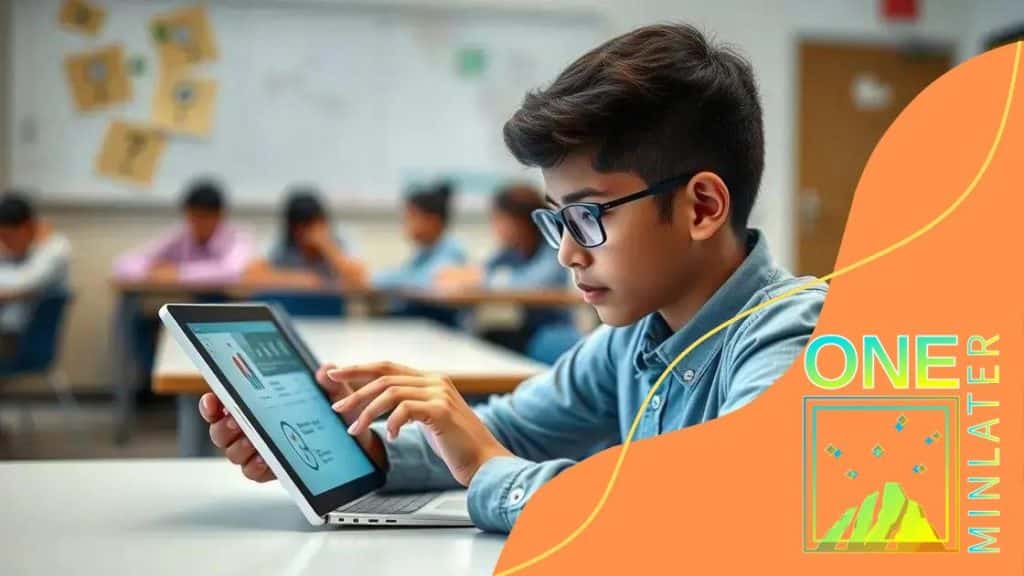AI-powered tutoring systems for personalized learning

AI-powered tutoring systems personalize learning by using advanced algorithms to tailor educational experiences, enhance student engagement, and improve academic outcomes through real-time feedback and adaptive learning pathways.
AI-powered tutoring systems for personalized learning are changing the education landscape. Have you ever wondered how these technologies customize learning experiences just for you? Let’s dive into how this innovation works and its impact on education.
Understanding AI-powered tutoring systems
Understanding AI-powered tutoring systems is essential as education evolves. These systems utilize advanced algorithms to tailor learning experiences specifically for individual students. With the help of artificial intelligence, tutoring becomes more efficient and engaging.
What are AI-powered tutoring systems?
At their core, these systems analyze student behaviors and preferences to adapt lessons accordingly. This means that every student receives a unique education, blocking out the traditional one-size-fits-all approach. The goal is to enhance learning outcomes by focusing on the challenges faced by each learner.
Key features of AI tutoring systems
- Personalized learning pathways: Students can progress at their own pace.
- Immediate feedback: Instant assessments help students improve in real-time.
- Data-driven insights: Educators can understand student performance better.
- Engaging content: Lessons are designed to keep students motivated.
With these features, AI tutoring systems foster a more interactive and effective learning environment. Students are encouraged to take charge of their learning, which builds confidence and motivation. Additionally, these systems use data analytics to identify learning gaps that can be addressed promptly.
Imagine a student who struggles with math concepts. An AI-powered tutoring system can pinpoint the exact area of difficulty and provide targeted exercises to help. This capability is what makes them so valuable in modern education.
Furthermore, AI-powered tutors adapt as the student progresses. If a student excels in a topic, the system can adjust to introduce more challenging material. This continuous adaptation keeps the learning process dynamic and effective, catering to the ever-changing needs of students.
Benefits of personalized learning solutions
The benefits of personalized learning solutions are becoming increasingly evident in education. Tailoring the learning experience to fit each student’s unique needs can significantly enhance their academic journey. These solutions not only provide greater engagement but also lead to improved outcomes.
Enhanced Engagement
Personalized learning keeps students more engaged because they work at their own pace. When students can choose their learning path, they feel a sense of ownership over their education. This engagement results in better retention of information. For instance, students who struggle in a subject can spend more time on that area while progressing quickly through topics they understand.
Improved Learning Outcomes
Studies have shown that personalized learning solutions can lead to higher grades and test scores. Since the content is tailored, students are more likely to grasp complex concepts. For example, an AI-powered tutoring system can identify areas where a student is struggling and provide targeted exercises, ensuring no one falls behind.
- Adaptable learning speeds: Students can advance as they master topics.
- Customized feedback: Real-time suggestions help improve understanding.
- Active participation: Greater involvement increases motivation.
- Diverse resources: Access to varied materials caters to different learning styles.
This adaptability is crucial in helping students build confidence. When learners see their progress, their motivation to succeed increases. Moreover, personalized learning solutions can address various learning styles. Visual learners might benefit from videos, while others may prefer hands-on activities.
Ultimately, the shift towards personalized education involves understanding each student’s individual journey. By leveraging AI technology and data analytics, educators can create environments where every student thrives. This is the future of learning—one where education is as unique as the learners themselves.
How AI shapes student engagement

Understanding how AI shapes student engagement is vital for modern education. With its innovative tools and techniques, AI can transform the way students interact with their learning environment. By utilizing personalized approaches, AI can make learning more appealing and raise motivation levels.
Creating Interactive Experiences
One major advantage of AI in education is its ability to create interactive and immersive experiences. For example, AI-powered learning platforms often incorporate gamification elements. This makes studying feel like a fun challenge rather than a chore. When students engage in playful activities, they are more likely to participate actively in their learning.
Personalized Content Delivery
AI helps tailor lessons to meet individual needs. The technology analyzes student data to provide personalized content that aligns with their interests and learning pace. This customization allows students to tackle subjects that intrigue them while setting aside topics they already grasp. Such flexibility fosters better understanding and keeps students excited about lessons.
- Real-time feedback: Immediate insights help students correct mistakes promptly.
- Adaptive learning: Systems adjust difficulty based on student performance.
- Varied learning styles: Catering to different preferences enhances retention.
- Increased collaboration: AI tools can promote interactive group activities.
Increased interaction with learning content can result in heightened curiosity. As students explore subjects more deeply, they naturally want to know more. AI also supports collaboration among peers. By connecting learners digitally, students can engage in discussions and share insights. This social connection enhances their overall learning experience.
Ultimately, AI serves as a valuable ally in keeping students motivated. By leveraging technology, educators can create a dynamic classroom where participation is encouraged. This isn’t just about using technology; it’s about fundamentally changing how students connect to their education.
Real-world examples of successful implementations
Real-world examples of successful implementations of AI-powered tutoring systems showcase how technology can effectively enhance education. Schools and educational institutions around the world are adopting these innovative systems to improve student engagement and learning outcomes. Let’s look at some compelling cases.
Example 1: Carnegie Learning
Carnegie Learning has developed an AI-driven math tutoring platform that helps students master concepts at their own pace. The system analyzes student performance in real-time, allowing teachers to receive insights and adjust their teaching strategies accordingly.
Example 2: Knewton
Knewton offers adaptive learning technology that customizes educational content for each student. By evaluating a learner’s strengths and weaknesses, Knewton provides personalized resources, making sure students focus on areas that need improvement.
- Impact on grades: Many students using Knewton have reported significant improvements in their academic performance.
- Increased retention: Personalized pathways help keep students engaged and motivated.
- Teacher support: Educators receive detailed analytics to guide their instruction.
These successful implementations demonstrate the potential of AI-powered solutions to transform learning. Schools that have integrated such systems report higher student satisfaction and a more collaborative classroom environment. For instance, a study conducted in a New Jersey school showed improved test scores after introducing AI tutoring.
Another notable example is the use of AI in personalized language learning. Duolingo utilizes AI algorithms to adapt language lessons based on the user’s progress. This approach not only makes learning fun but also ensures that users retain knowledge more effectively. Data shows users practicing more frequently when lessons are tailored to their skill level.
In places like Finland, educators are embracing AI technologies to enhance traditional teaching methods. Teachers use AI tools to create engaging lesson plans, allowing them to focus more on individual student needs. The integration of AI in classrooms offers exciting opportunities to improve the educational experience for everyone.
Future trends in AI tutoring systems
Future trends in AI tutoring systems are promising and exciting. As technology evolves, so does the potential for enhancing education through artificial intelligence. These trends aim to create more effective and personalized learning environments for students of all ages.
Integration of Virtual Reality
One significant trend is the integration of virtual reality (VR) into AI tutoring systems. VR environments can provide immersive learning experiences, allowing students to explore complex subjects in a more engaging way. For example, a history lesson could unfold in a virtual setting where students can witness historical events. This not only captivates students’ attention but also aids in better retention of information.
Increased Use of Data Analytics
Data analytics will play a crucial role in shaping AI tutoring systems. By collecting and analyzing large amounts of student data, these systems can fine-tune learning pathways. This means students receive content that aligns perfectly with their learning pace and style. The goal is to create a truly customized experience that addresses individual needs.
- Adaptive learning technologies: Future systems will be smarter, quickly adjusting to users’ needs.
- Enhanced gamification: More engaging game-like elements will be incorporated to boost motivation.
- Collaboration tools: Improved platforms for group learning will empower students to work together.
- AI teaching assistants: These tools will aid teachers by providing real-time support.
Furthermore, as AI becomes more advanced, educational institutions will likely use it to identify potential learning gaps even before students are aware of them. This predictive capability allows for timely interventions, providing support exactly when needed.
As we look toward the future, the role of AI in education will likely expand to include bringing in diverse resources. For instance, AI could curate content from various backgrounds and cultures, enriching learning experiences. This diversity helps students develop a broader perspective on the world around them.
Overall, the future trends in AI tutoring systems indicate a shift towards a more personalized, engaging, and efficient learning environment. As these technologies develop, students can expect to enjoy enhanced educational journeys that cater to their unique needs.
In conclusion, AI-powered tutoring systems represent a significant shift in how we approach education. They offer personalized learning experiences that adapt to each student’s needs. By incorporating trends like virtual reality and advanced analytics, these systems are enhancing student engagement and improving learning outcomes. As we continue to innovate in educational technology, the focus will remain on creating environments that support every learner’s path to success.
FAQ – Frequently Asked Questions about AI-Powered Tutoring Systems
How do AI tutoring systems personalize learning?
AI tutoring systems analyze individual student data to adapt lessons, ensuring each learner receives tailored support suited to their needs.
What are some benefits of using AI in education?
The main benefits include enhanced student engagement, real-time feedback, personalized learning experiences, and improved academic outcomes.
Will AI replace teachers in the classroom?
No, AI is meant to support teachers by providing tools and insights that enhance the learning experience, not to replace them.
What role does data analytics play in AI tutoring?
Data analytics helps monitor student performance, identify gaps in understanding, and adjust learning materials for better effectiveness.





